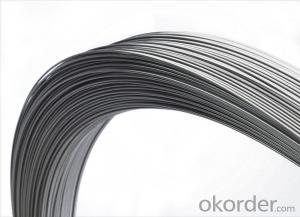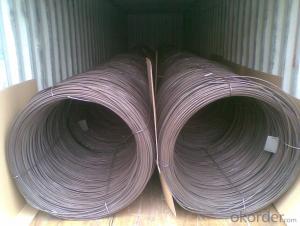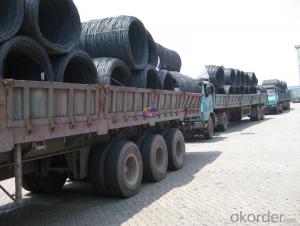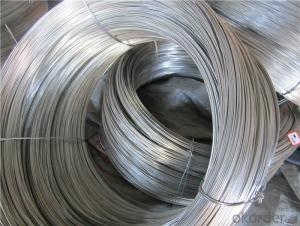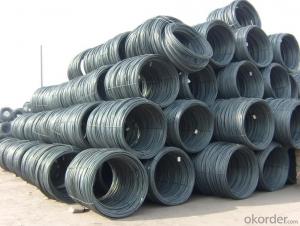SAE1006Cr Carbon Steel Wire Rod 16.5mm for Welding
- Loading Port:
- Shanghai
- Payment Terms:
- TT OR LC
- Min Order Qty:
- 100 m.t
- Supply Capability:
- 30000 m.t/month
OKorder Service Pledge
OKorder Financial Service
You Might Also Like
Item specifice
Description of SAE1006Cr Carbon Steel Wire Rod 16.5mm for Welding:
OKorder is offering Color Coated Steel Coil Prepainted Steel Coil at great prices with worldwide shipping. Our supplier is a world-class manufacturer of steel, with our products utilized the world over. OKorder annually supplies products to European, North American and Asian markets. We provide quotations within 24 hours of receiving an inquiry and guarantee competitive prices.
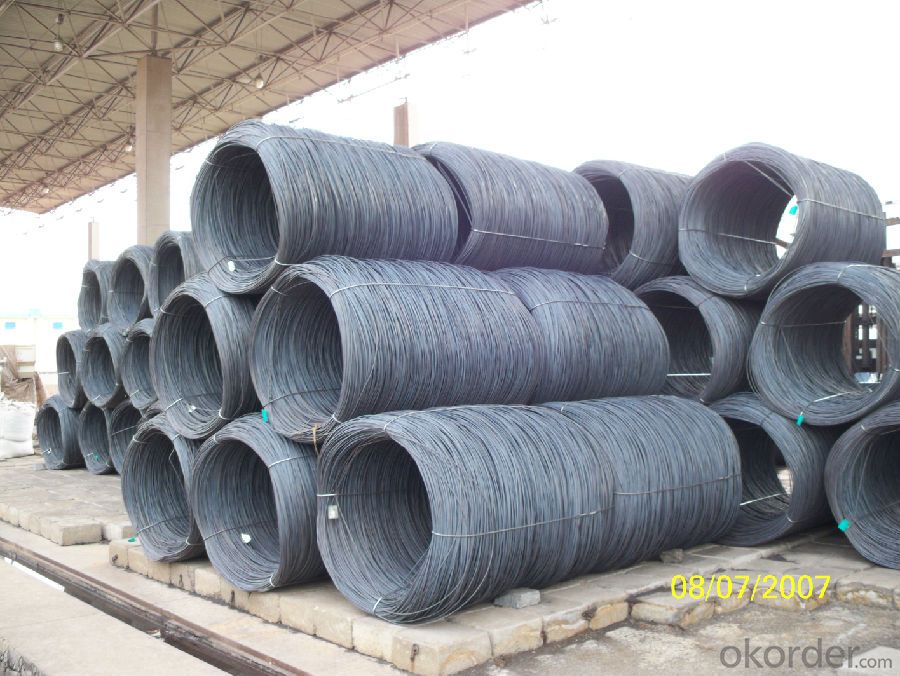
Applications of SAE1006Cr Carbon Steel Wire Rod 16.5mm for Welding:
Color Coated Steel Coil Prepainted Steel Coil are ideal for structural applications and are widely used in the construction of buildings and bridges, and the manufacturing, petrochemical, and transportation industries.
Main Product Features of SAE1006Cr Carbon Steel Wire Rod 16.5mm for Welding:
· Premium quality
· Prompt delivery & seaworthy packing (30 days after receiving deposit)
· Corrosion resistance
· Can be recycled and reused
· Mill test certification
· Professional Service
· Competitive pricing
Specifications of SAE1006Cr Carbon Steel Wire Rod 16.5mm for Welding:
1, Introduction: Color coated steel coils(sheets), i. E. PPGI, also called prepainted steel coils(sheets), are made of galvanized steel coils(sheets) with polymer coatings as surface. It's a new enclosure material and building board with characteristics of light-weighted, heat preserved&insulated, easily installed with bright colors.
2, Production Process: Pretreatment(Degreasing)_Drying_Chromating_Paint Basic Oil_Cooling_Drying_Color Coating_Cooling_Film-covering_Rolling Up
3, Characteristics:
Good at corrosion resistence. Besides zinc coating of the basic plate of galvanized steel sheet, the color coating as the surface has double lifetime to ensure better anticorrosion effect.
With excellent cold bending molded manufacturablity, PPGI products can be processed or directly used as final product. As being light-weighted and conveniently transported, they're widly used to replace wood to save energy.
4.There're thousands of colors can be chosen as per different application. Any color plays well in decoration.
No pollution with high recycling rate, PPGI coils and sheets are strongly recommended as enviroment-friendly products by the government.
5, eye bands and 4 circumferential bands in steel, galvanized metal fluted rings on inner and outer edges, galvanized.
| commodity | SAE1006Cr Carbon Steel Wire Rod 16.5mm for Welding |
| Techinical Standard: | JIS G3302-1998, EN10142/10137, ASTM A755 |
| grade | Q195,Q215,Q235,SAE1006,SAE1008 SAE1006Cr |
| Types: | Mesh welding |
| Base metal | galvanized, galvalume, cold rolled steel |
| Thickness | 0.14-1.0mm(0.16-0.8mm is the most advantage thickness) |
| Width | 610/724/820/914/1000/1200/1219/1220/1250mm |
| Type of coating: | PE, SMP, PVDF |
| Zinc coating | Z60-150g/m2 or AZ40-100g/m2 |
| Top painting: | 5 mic. Primer + 15 mc. R. M. P. |
| Back painting: | 5-7 mic. EP |
| Color: | According to RAL standard |
| ID coil | 508mm610mm |
| Coil weight: | 2--3MT |
| Package: | Properly packed for ocean freight exportation in 20'containers |
| Application: | Industrial panels, roofing and siding for painting/automobile |
| Price terms | FOB, CFR, CIF |
| Payment terms | 20%TT in advance+80% TT or irrevocable 80%L/C at sight |
| delivery time | 25 days after recepit of 20% TT |
| Remarks | Insurance is all risks |
| MTC 3.1 will be handed on with shipping documents | |
| We accept SGS certificatation test |
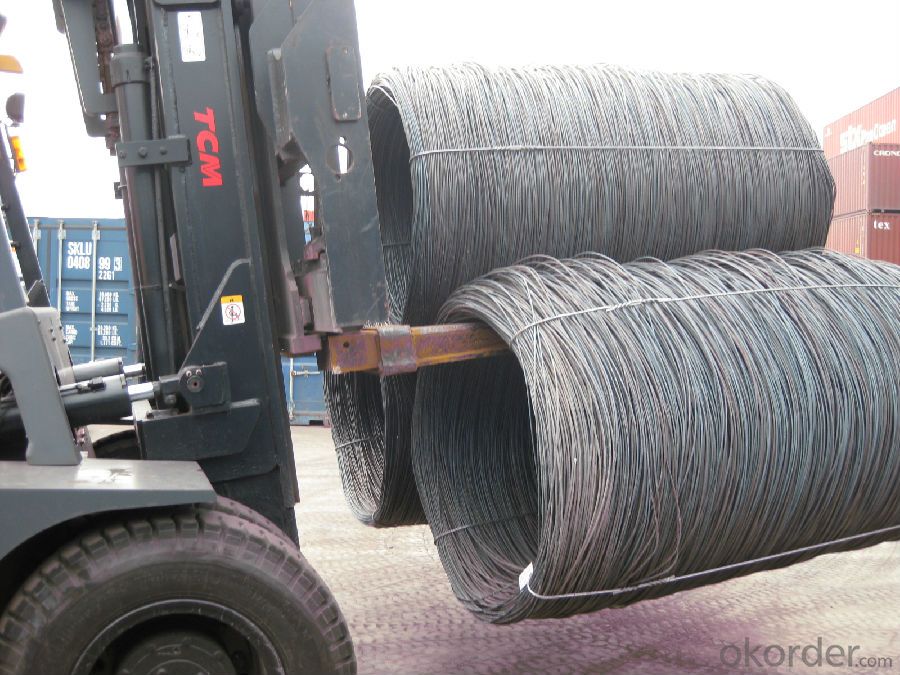
FAQ of SAE1006Cr Carbon Steel Wire Rod 16.5mm for Welding:
Q1: Why buy Materials & Equipment from OKorder.com?
A1: All products offered byOKorder.com are carefully selected from China's most reliable manufacturing enterprises. Through its ISO certifications, OKorder.com adheres to the highest standards and a commitment to supply chain safety and customer satisfaction.
Q2: How do we guarantee the quality of our products?
A2: We have established an advanced quality management system which conducts strict quality tests at every step, from raw materials to the final product. At the same time, we provide extensive follow-up service assurances as required.
Q3: How soon can we receive the product after purchase?
A3: Within three days of placing an order, we will begin production. The specific shipping date is dependent upon international and government factors, but is typically 7 to 10 workdays.
Q4: What makes stainless steel stainless?
A4: Stainless steel must contain at least 10.5 % chromium. It is this element that reacts with the oxygen in the air to form a complex chrome-oxide surface layer that is invisible but strong enough to prevent further oxygen from "staining" (rusting) the surface. Higher levels of chromium and the addition of other alloying elements such as nickel and molybdenum enhance this surface layer and improve the corrosion resistance of the stainless material.
Q5: Can stainless steel rust?
A5: Stainless does not "rust" as you think of regular steel rusting with a red oxide on the surface that flakes off. If you see red rust it is probably due to some iron particles that have contaminated the surface of the stainless steel and it is these iron particles that are rusting. Look at the source of the rusting and see if you can remove it from the surface.
- Q:What are the major innovations in steel wire rod production technology?
- Some of the major innovations in steel wire rod production technology include the introduction of continuous casting technology, which allows for more efficient production and better quality control. The development of advanced rolling mills that can produce wire rods with precise dimensions and surface quality has also been a significant innovation. Additionally, the integration of automation and digital technologies into the production process has led to increased productivity and improved product consistency.
- Q:What are the different types of wire mesh for sieving made from steel wire rod?
- Steel wire rod is used to create various types of wire mesh for sieving. These include: 1. The most commonly used wire mesh for sieving is plain weave. It is created by weaving steel wire rods together in an over-and-under pattern, resulting in a square or rectangular mesh structure. Plain weave wire mesh is known for its simplicity and versatility. 2. Twill weave wire mesh is similar to plain weave, but the wires are interlaced diagonally, resulting in a tighter mesh structure. This type of wire mesh is often employed for fine sieving applications that require a higher level of precision. 3. Dutch weave wire mesh is made by weaving the wires in an over-and-under pattern, but with varying wire diameters for the warp and weft wires. This creates a mesh with smaller openings in one direction, which is ideal for separating fine particles. 4. Welded wire mesh is formed by welding the intersecting points of the steel wires together, resulting in a durable and robust mesh structure. It is commonly used for heavy-duty sieving applications, such as in construction or industrial settings. 5. Expanded metal mesh is produced by cutting and stretching a flat sheet of steel, creating a mesh with diamond-shaped openings. This type of wire mesh is known for its strength and rigidity, making it suitable for sieving applications that require high impact resistance. In conclusion, there is a wide range of wire mesh options made from steel wire rod for sieving purposes. The choice of wire mesh depends on factors such as particle size, desired precision, and the intended use of the sieved material.
- Q:What are the major barriers to entry in the steel wire rod market?
- The major barriers to entry in the steel wire rod market can be attributed to several factors. Firstly, the high capital requirements present a significant barrier for new entrants. Establishing a steel wire rod production facility requires substantial investment in machinery, equipment, and infrastructure. Additionally, the costs associated with raw materials, such as iron ore and scrap metal, further add to the financial burden. This high capital requirement limits the entry of new players, as they may struggle to secure the necessary funds to compete with established industry participants. Secondly, economies of scale play a crucial role in the steel wire rod market. Existing manufacturers often benefit from a larger production base, enabling them to achieve cost efficiencies through bulk purchasing, streamlined production processes, and distribution networks. This advantage makes it difficult for new entrants to compete on a cost basis, as they would need to achieve similar economies of scale to remain competitive. Furthermore, the steel wire rod market is highly competitive, with a few dominant players holding significant market share. These established companies have strong brand recognition, longstanding customer relationships, and established distribution channels. This makes it challenging for new entrants to gain market share and attract customers away from these well-established players. Regulatory barriers also pose challenges for new entrants. The steel industry is subject to various government regulations and compliance requirements, including environmental regulations and safety standards. These regulations can be complex and costly to navigate, adding further barriers to entry for potential new players. Lastly, technological advancements and innovation are essential in staying competitive in the steel wire rod market. Existing manufacturers often have access to advanced technology and research and development capabilities, allowing them to produce higher quality products and drive efficiency improvements. New entrants may struggle to match these technological capabilities, making it difficult to gain a competitive edge. In summary, the major barriers to entry in the steel wire rod market include high capital requirements, economies of scale, strong competition from established players, regulatory compliance, and technological advancements. These barriers make it challenging for new entrants to penetrate the market and establish a foothold.
- Q:What are the factors that influence the mechanical properties of steel wire rod?
- The mechanical properties of steel wire rods can be influenced by several factors. These factors encompass: 1. Composition: The mechanical properties of steel are determined by its chemical composition, including the presence of alloying elements. Alloying elements like carbon, manganese, silicon, and others can affect the wire rod's strength, hardness, and ductility. 2. Microstructure: The mechanical properties of steel are greatly influenced by its microstructure, which is determined by factors like cooling rate and heat treatment. The arrangement of grains, impurity presence, and size and distribution of precipitates can all impact the wire rod's strength, toughness, and other properties. 3. Processing conditions: During the production of wire rods, the mechanical properties can be significantly affected by processing conditions such as temperature, cooling rate, and rolling conditions. Controlled cooling rates, for example, can result in a fine-grained microstructure that enhances the wire rod's strength and toughness. 4. Heat treatment: Heat treatment processes like annealing, quenching, and tempering can further modify the mechanical properties of steel wire rods. These processes refine the microstructure, relieve internal stresses, and improve the wire rod's strength, hardness, and ductility. 5. Surface finish: The mechanical properties of the wire rod can also be influenced by its surface finish, including factors like scale, decarburization, and surface defects. A smooth and clean surface contributes to better fatigue resistance and overall mechanical performance. 6. Size and shape: The mechanical properties of wire rods can be influenced by their size and shape, including diameter and cross-sectional profile. Thicker rods tend to have higher strength but lower ductility, while thinner rods may exhibit higher ductility but lower strength. 7. Environmental conditions: The mechanical properties of steel wire rods can also be affected by environmental conditions in which they are used. Factors like temperature, humidity, and exposure to corrosive substances can impact the wire rod's strength, toughness, and corrosion resistance. Considering these factors is crucial when selecting or designing steel wire rods for specific applications, as they greatly impact the performance and reliability of the final product.
- Q:What are the common documentation requirements for steel wire rod?
- The common documentation requirements for steel wire rod typically include the product specifications, test certificates, mill certificates, packing lists, and shipping documents such as bills of lading or airway bills. These documents provide crucial information about the quality, origin, and shipment of the steel wire rod, ensuring transparency and compliance with industry standards.
- Q:What are the common quality control measures for steel wire rod?
- Some common quality control measures for steel wire rod include conducting visual inspections for defects such as surface cracks or imperfections, performing dimensional checks to ensure the rod meets specified size and shape requirements, conducting mechanical tests to evaluate its strength and durability, and conducting chemical analysis to verify the composition and purity of the steel. Additionally, quality control measures may involve conducting non-destructive testing techniques such as ultrasonic testing or magnetic particle inspection to identify any internal flaws or defects that may affect the performance of the wire rod.
- Q:How is steel wire rod used in the manufacturing of wire forms for automotive exhaust systems?
- The manufacturing of wire forms for automotive exhaust systems heavily relies on steel wire rod. These wire forms are essential for providing structural support and stability to the exhaust system, ensuring its optimal functioning and long lifespan. To begin with, steel wire rod is employed to construct the primary framework of the wire form, which serves as the backbone of the exhaust system. This framework is responsible for securely holding and positioning various components of the exhaust system, including the muffler, catalytic converter, and pipes. The remarkable tensile strength and durability of steel wire rod make it an ideal choice for this purpose, as it can withstand the intense vibrations, heat, and pressure that the exhaust system encounters. Furthermore, steel wire rod is utilized to shape the hangers and brackets that fasten the exhaust system to the vehicle's chassis. These hangers and brackets are crucial for maintaining the correct alignment and stability of the exhaust system, preventing any unnecessary movement or rattling. The flexibility and malleability of steel wire rod enable it to be easily formed into the desired hanger or bracket design, ensuring a precise fit and dependable performance. Moreover, steel wire rod is also employed in the fabrication of wire mesh screens and filters that are installed within the exhaust system. These screens and filters play a vital role in trapping and eliminating contaminants, such as particulate matter and harmful gases, from the exhaust gases before they are released into the environment. The exceptional strength and corrosion resistance of steel wire rod make it an excellent choice for constructing these screens and filters, as they must endure harsh operating conditions and exposure to corrosive elements. In conclusion, steel wire rod plays a critical role in the manufacturing of wire forms for automotive exhaust systems. Its impressive tensile strength, durability, flexibility, and corrosion resistance make it the ideal material for constructing the main framework, hangers, brackets, and screens/filters within the exhaust system. By utilizing steel wire rod, manufacturers can ensure that the wire forms provide the necessary structural support, stability, and reliability required for the proper functioning of automotive exhaust systems.
- Q:How is steel wire rod used in the manufacturing of wire strands for suspension bridges?
- Steel wire rod is used in the manufacturing of wire strands for suspension bridges by being drawn and twisted together to create strong and durable cables. These cables are then used to support the weight of the bridge, ensuring its stability and ability to withstand heavy loads.
- Q:What are the different storage methods for steel wire rod?
- The storage of steel wire rod varies depending on factors such as quantity, size, and condition. There are multiple methods available. One option is to stack the wire rod neatly and in an organized manner. This involves creating rows of wire rod coils on a stable surface like a concrete floor or a specially designed storage rack. It is crucial to stack the coils in a way that prevents rolling or collapsing for safety and easy access. Another method is to use wire rod racks or shelves. These racks are specifically designed to securely hold wire rod coils and prevent them from rolling or shifting. They often have dividers or compartments to keep each coil separate and well-organized. Vertical racks or stands can also be used, particularly when dealing with longer wire rod lengths. This method saves floor space by placing the rod vertically and securing it in place. For outdoor storage, designated areas with storage containers or shipping containers can be used. This provides protection from the elements and ensures the rod remains in good condition. Regardless of the chosen storage method, it is essential to protect the wire rod from moisture, dust, and other contaminants. This can be achieved by using plastic or metal covers or storing the rod in a climate-controlled environment. It's important to note that the specific storage method may vary depending on industry standards, regulations, and the specific requirements of the wire rod product. Consulting with industry experts or manufacturers is always recommended to determine the most suitable storage method for steel wire rod.
- Q:How is steel wire rod used in the manufacturing of wire rope thimbles?
- Steel wire rod is used in the manufacturing of wire rope thimbles by being shaped, formed, and cut into the desired size and shape to create the base structure of the thimble. The steel wire rod is strong and durable, ensuring that the thimble can withstand heavy loads and provide support to the wire rope. Additionally, the steel wire rod is often galvanized or coated to enhance its corrosion resistance, ensuring the longevity and reliability of the wire rope thimble.
1. Manufacturer Overview |
|
|---|---|
| Location | |
| Year Established | |
| Annual Output Value | |
| Main Markets | |
| Company Certifications | |
2. Manufacturer Certificates |
|
|---|---|
| a) Certification Name | |
| Range | |
| Reference | |
| Validity Period | |
3. Manufacturer Capability |
|
|---|---|
| a)Trade Capacity | |
| Nearest Port | |
| Export Percentage | |
| No.of Employees in Trade Department | |
| Language Spoken: | |
| b)Factory Information | |
| Factory Size: | |
| No. of Production Lines | |
| Contract Manufacturing | |
| Product Price Range | |
Send your message to us
SAE1006Cr Carbon Steel Wire Rod 16.5mm for Welding
- Loading Port:
- Shanghai
- Payment Terms:
- TT OR LC
- Min Order Qty:
- 100 m.t
- Supply Capability:
- 30000 m.t/month
OKorder Service Pledge
OKorder Financial Service
Similar products
New products
Hot products
Related keywords
